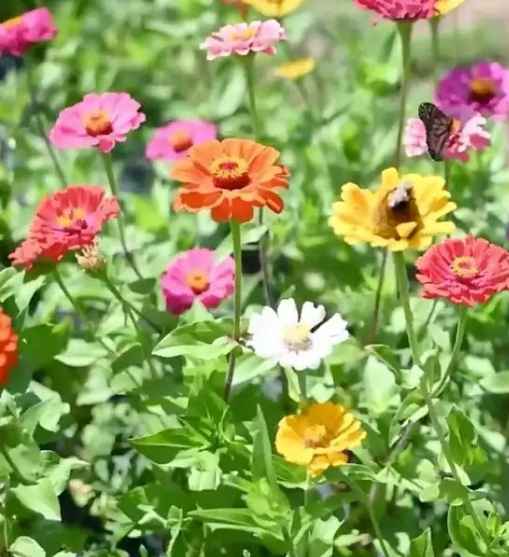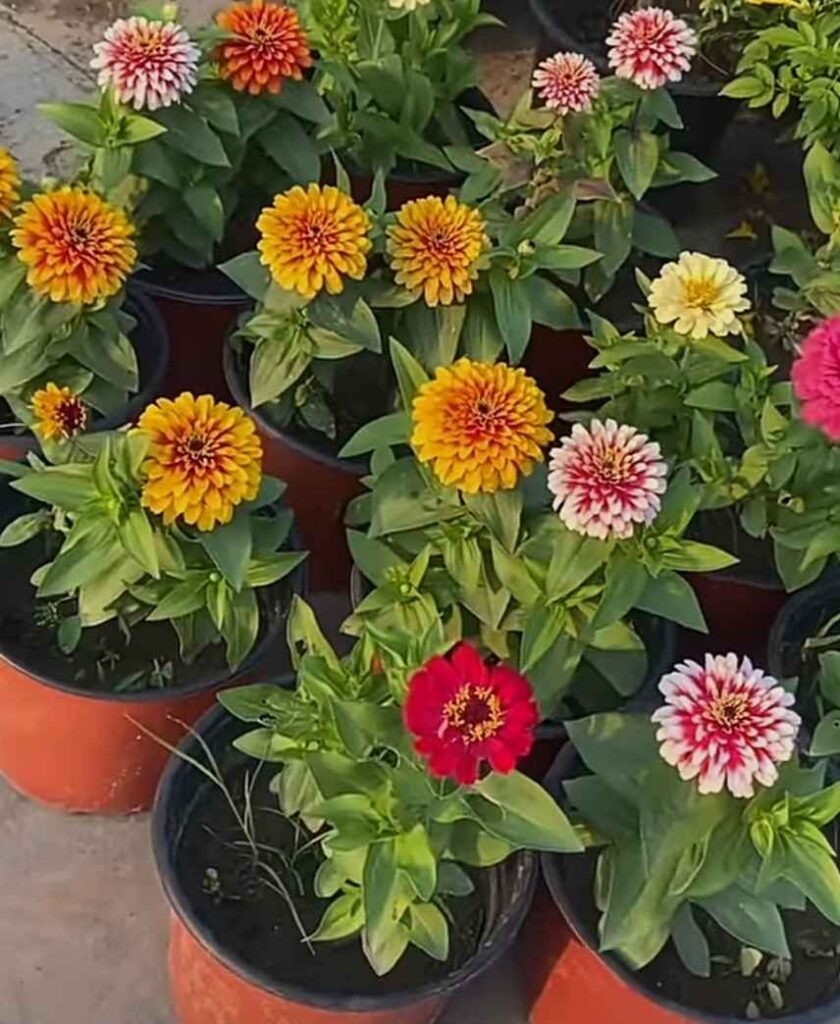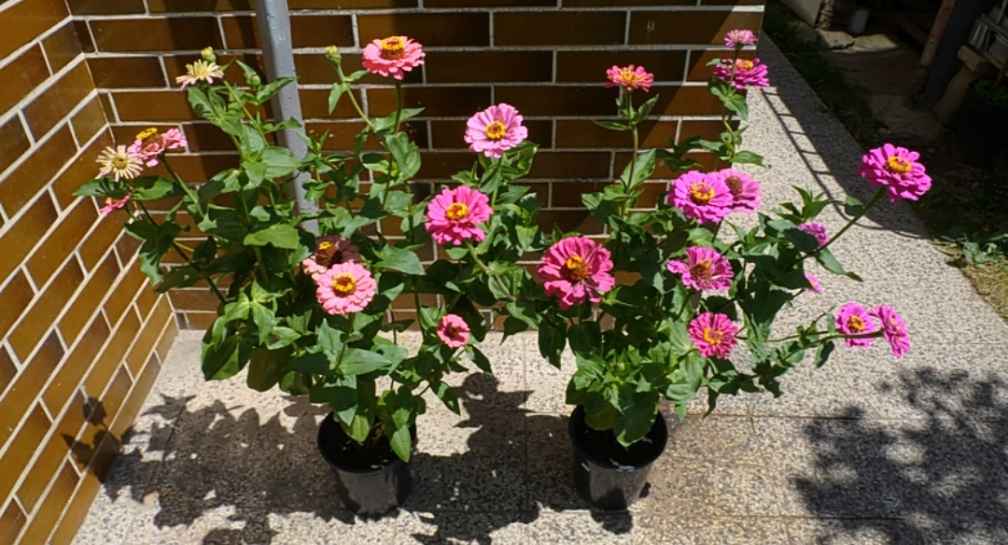Growing zinnias in pots is an excellent choice for those with limited outdoor space or urban gardeners looking to add a splash of colour to their living space. These cheerful and colourful flowers are ideal for containers, thriving in well-draining soil with regular watering and adequate sunlight. When exploring how to grow zinnias in pots, you’ll discover various types, including single zinnias with flat flowers and double zinnias with pom blooms in bold brights or soft pastels. Whether growing petite, short-growing varieties or towering zinnias that reach a metre tall, these plants will enhance your space.
Also, read my guide on:
Best Zinnia Companion Plants for a Vibrant Garden
Zinnias are known for attracting bees, butterflies, and other beneficial insects, making them an excellent addition to any garden. Their ability to grow well in pots allows you to move them around or relocate them as the growing season progresses. To get started, you can either start seeds indoors or buy young plants to place in containers. The right pot size and soil quality ensure the vibrant zinnias reach their full potential.
These summer flowering annual plants are space-efficient and require minimal maintenance, making them ideal for a container garden. Using a pot with good drainage allows zinnias to thrive and bring aesthetic charm to your outdoor or indoor spaces. With their diverse colours and shapes, zinnias add great beauty to your container garden. Whether using them as a focal point or to fill small spaces, they will brighten up any corner with their vibrant colors and appeal.
Some varieties of zinnias can grow as tall as 1 meter, while others remain much smaller, typically ranging from 15-20 cm. This versatility means there’s a zinnia for every space, from tiny patios to larger container setups. These stunning flowers can thrive with adequate sunlight and care, offering a colorful and vibrant display throughout the warmer months.
Why Grow Zinnias
There are many reasons why zinnias are an ideal plant to grow, whether you’re a beginner or an experienced gardener. Zinnias are easy to grow, making them perfect for those new to gardening or those with limited time. They come in a wide range of vibrant colors, from bright, bold hues to softer tones, adding instant color to any space. These flowers are also low maintenance, requiring minimal attention once established, making them a great choice for busy gardeners.
Versatility and Beauty
In addition to their beauty, zinnias are versatile plants. They are excellent cut flowers that last a long time in a vase, with strong long stems that make them perfect for floral arrangements and bouquets. Zinnia flowers also work well in dried flower crafts, offering an extended use beyond their blooming season. They thrive in pots and containers, which makes them an ideal choice for balcony gardens, patios, or urban spaces. With their adaptability, zinnias can withstand hot, dry summers, making them a perfect fit for areas with water restrictions or drought tolerance.
Pollinator-Friendly
Another reason to grow zinnias is their ability to attract pollinators, such as bees, butterflies, and even hummingbirds. These insects help boost biodiversity in your garden, making it a lively and thriving space. Zinnias’ long blooming period, from early summer through fall, ensures that your garden will enjoy continuous color. Their ability to bloom for an extended season adds an extra layer of joy and beauty. At the same time, their minimal maintenance requirements allow you to enjoy their vibrant display without much effort.
Gardening Experience and Joy
Finally, growing zinnias provides a rewarding gardening experience. Whether nurturing them in containers or gardens, these plants allow you to connect with nature, express your creativity, and enjoy caring for living plants. Zinnias are not only a treat for the eyes but also offer a sense of accomplishment and beauty that will enhance your gardening enjoyment.

When to Grow Zinnias in Pots
The timing of growing zinnias in pots is key to ensuring they thrive. It’s best to wait until after the last frost date in your area, usually around late spring or early summer, when the risk of cold weather has passed. This is when the soil is warm enough for the seeds or seedlings to grow strong and healthy. Zinnias will begin to bloom shortly after, adding vibrant color to your pots throughout the season.
Selecting the Right Pot for Zinnias
When selecting the right pot for your zinnia plants, it’s important to choose a container with enough ample space to allow the root system to grow properly. A pot with a diameter of at least 12 inches is ideal for promoting healthy root development. Smaller pots can restrict the roots, leading to stunted plants that won’t thrive. Also, ensure the pot has drainage holes at the bottom to prevent waterlogging and avoid issues like root rot.
For the best growth, use a suitable potting soil mix that helps maintain soil moisture and supports healthy growth. If you’re growing in terracotta or clay pots, these materials are porous, allowing for good air circulation and moisture evaporation. However, they may dry out faster, so you may need to water more often. On the other hand, plastic or resin pots are lightweight and retain moisture, making them a great choice for hot or dry climates, as they require less frequent watering.
Selecting the Right Soil
When growing zinnias in pots, a high-quality potting mix is essential for their health and growth. Look for a well-draining, nutrient-rich soil mix that provides the right balance of moisture retention and aeration. Zinnias prefer absorbent soil, so consider choosing mixes that contain vermiculite or peat moss to help with moisture control and improve the soil’s ability to hold water without becoming soggy.
Add manure or compost to the mix for the best results, as zinnias are moderate feeders and benefit from well-aged nutrients. These additions help the plants grow strong and vibrant. A good mix will balance nutrients and moisture, ensuring that your zinnia plants thrive in containers without struggling from lack of nutrients or overwatering. When preparing the soil, ensure it is absorbent and well-drained for the healthiest zinnias possible.
Selecting the Right Location
Zinnias are sun worshippers and thrive in full sun, so choosing a spot where they will get 6-8 hours of sunlight a day is important. To ensure they grow strong and vibrant, place your pots in a location that allows them to soak up as much sunlight as possible. However, if you’re in an area with excessive heat, you may want to find a spot with partial shade during the hottest part of the day to protect the plants from overheating.
It’s also important to consider the wind when selecting a location. Zinnias can be tall and may not fare well in strong winds. Placing pots near a border wall or on a flower plot can help shield them from wind damage. For strategic placement, the front porch or back patio are great options, allowing you to show off your zinnias and give them the necessary sunlight. Plus, you can easily move the pots around to adjust to changing weather conditions, making your garden fun and adaptable.
Tips for Growing Zinnias From Seed
Start indoors: Begin zinnia seeds indoors in cells about 4-6 weeks before the last spring frost.
Plant depth: Bury the seeds ½ inch deep in a well-draining seed starting mix.
Soil temperature: For optimal germination, keep the soil temperature between 74 ° and 80 °, using heat mats if needed.
Watering: Water the soil thoroughly, ensuring it’s saturated but not soggy.
Germination: Expect germination within 5-7 days.
Transplanting: Once seedlings grow, transplant them into a pot of the correct size or direct-sow outside after the last frost when the soil temperatures are around 60°.
Space plants: Ensure enough space between the plants to avoid them becoming rootbound.
Prevent stress: Avoid stressed plants by giving them enough space to grow properly.
Transplant shock: Gradually introduce them to the outdoor soil to reduce transplant shock.
Transplant Zinnia Seedlings
When it’s time to transplant zinnia seedlings, ensure they are 3 to 4 inches tall and have developed their true leaves. This is an important step in the growth process. Wait until the danger of frost has passed and the seedlings are ready to move into larger pots or your garden bed.
Choose a transplanting site with full sun, as zinnias are sun-loving plants. If you use containers, ensure they have clean containers with drainage holes. Proper drainage is key to avoiding waterlogging and stress on the roots. Carefully remove the seedlings from their original pots using a trowel or your fingers, being gentle with the delicate roots. When planting, dig a hole deep enough for the root ball and place the plant so that the top of the root ball is level with the soil surface. Backfill the hole and gently press down to eliminate air pockets.
After transplanting, water the seedlings thoroughly with rainwater or from a water butt. Consistently moist soil is essential, but avoid overwatering, which can lead to disease. To protect the plants from extreme conditions, apply organic mulch such as straw or wood chips around the base to help retain moisture and keep the soil cool. In the early stages, keep the seedlings in a sheltered location with bright sunlight, gradually increasing their exposure to direct sunlight over a week or two.
General Care for Zinnias in Pots
Sun Exposure
Zinnias thrive in full sun, as they require bright sunlight for healthy growth. The plants may become weak and struggle to bloom if grown in a shaded area. Ensure the soil is well-draining but remains consistently moist—avoid letting it become waterlogged, as this can lead to root rot. After transplanting seedlings, it’s important to monitor them for signs of stress or disease. The first few weeks after transplanting are crucial, so take action immediately if you notice wilting or discoloration.
Hardening Off
Before transplanting your zinnias outdoors, it’s essential to introduce them to outdoor conditions to reduce shock gradually. Start by placing them in a sheltered area for a few hours each day, increasing their exposure to direct sunlight over a week or two. This process ensures they can thrive when planted in a spot with a minimum of 6 to 8 hours of ample sunlight. The sun’s intensity can impact flower colors, and while zinnias love sunlight, extremely intense heat during the scorching afternoon can be stressful. To prevent damage, provide shade during the hottest afternoon hours using shade cloth, umbrellas, or by moving pots to a shadier location.
Staking
Zinnias, especially those grown for cutting, benefit from being supported to keep them upright. Individual stakes, such as bamboo or hazel canes, work well for larger plants. In a veg-cutting garden, pea or jute netting stretched horizontally over young plants can help them grow straight. A grid setup ensures they stay supported as new leaves and growth develop. Applying netting early prevents damage and supports plants throughout the season.
Fertilizing
Regular fertilizing with a liquid feed every 4 to 6 weeks after planting is beneficial, as container nutrients deplete over time. A balanced fertilizer or compost will encourage strong stems, preventing collapse while keeping plants growing and flowering vertically supported.
Pest and Disease Management
Pests and diseases can plague Zinnias, but using organic methods helps maintain a healthy garden ecosystem. Companion planting with flowers that deter insects is an effective management strategy. Regular inspections help catch issues early, ensuring your zinnias stay healthy and vibrant throughout the season.

How to Deadhead Zinnias in Pots
Deadheading is essential for encouraging continuous flowering in potted zinnias. Removing spent blooms helps the plant stimulate new growth and prolong the blooming season. The best way to do this is to regularly check your plants and remove wilted flowers as soon as they fade or wilt. Use clean, sharp scissors or pruning shears to snip dead flower heads, cutting just above a set of healthy leaves or a lateral bud. This method prevents the plant from expending seed production energy and stimulates growth for new flower buds.
During the growing season, it’s important to deadhead ideally every few days to keep your plants tidy and promote continuous flowering. The more you cut, the more your zinnias will bloom, creating a bountiful display of color. By incorporating deadheading into your zinnia care routine, you can enjoy a garden or indoor space filled with colorful flowers that brighten your surroundings all season long.
Also, read my guide on:
Shade Tolerant Clematis for Your Garden’s Beauty
Final Observations
Once you master the basics of growing zinnias in pots, you’ll be rewarded with a stunning display of vibrant blooms that last all season. Whether you’re nurturing them in a small balcony garden or using them to add a pop of color to your patio, these low-maintenance flowers will thrive with proper care. From choosing the right pot and soil to deadheading spent blooms, small efforts will ensure continuous flowering. With their ability to attract pollinators, withstand hot summers, and brighten up any space, zinnias are a must-have for any container garden.
FAQs
Q- Do zinnias do well in pots?
Yes, zinnias thrive in pots as long as they have well-draining soil, ample sunlight, and regular watering.
Q- Do zinnias like full sun or shade?
Zinnias prefer full sun and need at least 6–8 hours of direct sunlight daily for healthy growth and abundant blooms.
Q- How do you keep zinnias short and bushy?
Pinch the tips of young plants to encourage branching and compact growth. Regular deadheading also helps maintain a bushy shape.
Q- How do I keep zinnias blooming all summer?
Deadhead spent flowers, provide consistent watering, and fertilize every 4–6 weeks to promote continuous blooms throughout the season.










